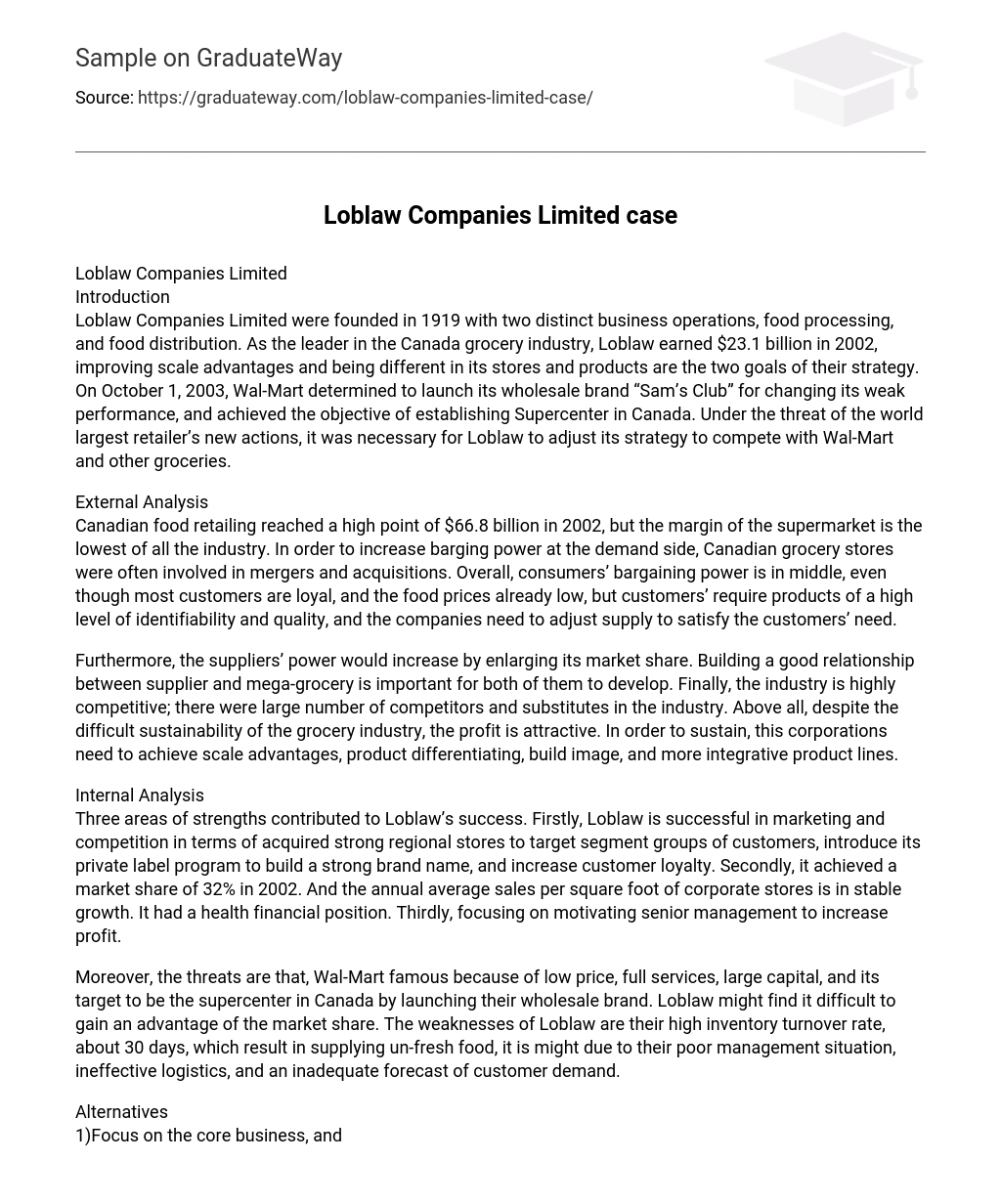Loblaw Companies Limited
Introduction
Loblaw Companies Limited were founded in 1919 with two distinct business operations, food processing, and food distribution. As the leader in the Canada grocery industry, Loblaw earned $23.1 billion in 2002, improving scale advantages and being different in its stores and products are the two goals of their strategy. On October 1, 2003, Wal-Mart determined to launch its wholesale brand “Sam’s Club” for changing its weak performance, and achieved the objective of establishing Supercenter in Canada. Under the threat of the world largest retailer’s new actions, it was necessary for Loblaw to adjust its strategy to compete with Wal-Mart and other groceries.
External Analysis
Canadian food retailing reached a high point of $66.8 billion in 2002, but the margin of the supermarket is the lowest of all the industry. In order to increase barging power at the demand side, Canadian grocery stores were often involved in mergers and acquisitions. Overall, consumers’ bargaining power is in middle, even though most customers are loyal, and the food prices already low, but customers’ require products of a high level of identifiability and quality, and the companies need to adjust supply to satisfy the customers’ need.
Furthermore, the suppliers’ power would increase by enlarging its market share. Building a good relationship between supplier and mega-grocery is important for both of them to develop. Finally, the industry is highly competitive; there were large number of competitors and substitutes in the industry. Above all, despite the difficult sustainability of the grocery industry, the profit is attractive. In order to sustain, this corporations need to achieve scale advantages, product differentiating, build image, and more integrative product lines.
Internal Analysis
Three areas of strengths contributed to Loblaw’s success. Firstly, Loblaw is successful in marketing and competition in terms of acquired strong regional stores to target segment groups of customers, introduce its private label program to build a strong brand name, and increase customer loyalty. Secondly, it achieved a market share of 32% in 2002. And the annual average sales per square foot of corporate stores is in stable growth. It had a health financial position. Thirdly, focusing on motivating senior management to increase profit.
Moreover, the threats are that, Wal-Mart famous because of low price, full services, large capital, and its target to be the supercenter in Canada by launching their wholesale brand. Loblaw might find it difficult to gain an advantage of the market share. The weaknesses of Loblaw are their high inventory turnover rate, about 30 days, which result in supplying un-fresh food, it is might due to their poor management situation, ineffective logistics, and an inadequate forecast of customer demand.
Alternatives
1)Focus on the core business, and develop a growth strategy. 2)To develop business through acquisition.
Discussion of Alternatives ( 5 is the highest)
Profit (40%)-Cost (25%) MKT share (20%)Brand identification (15%)Total Core business4-2342.3
Acquisition5-3452.8
According to my analysis, Loblaw develop by acquisition or merger is a better strategy.
Recommendations
a)Short-term
1) Segmenting customers in different groups and analyzing the customers’ behaviors, not only to know which group grew rapidly, but also identify Loblaw’s weakness of attracting those customers. Further more, acquiring the particular grocery companies has this group of loyalty customers. For example, as the increased demand for Asian food, Loblaw acquired T&T to target Asian people. 2) Loblaw acquired other famous retailing companies to enlarge its market share and increase brand image. (Loblaw had acquired Shoppers on July 14, 2013) 3) Use IT package to improve logistics, forecast demand, reduce inventory and guarantee fresh food quality. In the meanwhile, it would advance the old strategy, in which increasing cost effectiveness solely depends on economy of scale. b) Middle- term
1) Launching a new high-end private label to increase value of the brand and provide more integrative of products. 2) Decreasing the ownership of fixed assets, and use the money to develop on-line business. 3) In order to improve the customers’ shopping experiences, stores identification, and increase “store-as-a-brand” impression, Loblaw could redesign, organize, and integrate stores’ internal arrangement and its outside appearance. c) Long-term
Analysis other national markets, get opportunities of entering to the low competitive, and higher margin overseas market by acquisition of local middle-size grocery companies.
Conclusion
During the analysis of the environment of Loblaw, comparing the future strategy, development by acquisition is a better choice. Furthermore, the company can grow by set stage goals, and based on the advantage of market share in Canadian retailer market, control famous label program, good experience at marketing, and good financial position.





